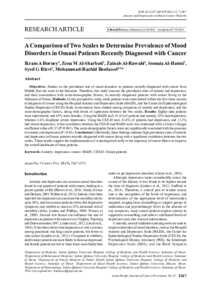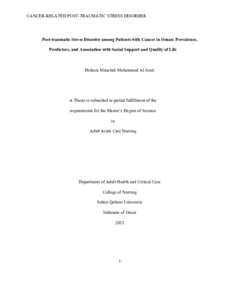وثيقة
Prevalence and patterns of psychotropic medication use among cancer patients at Sultan Qaboos Comprehensive Cancer Care and Research (SQCCCRC), Oman : a cross-sectional study.
المصدر
Master's thesis
عناوين أخرى
معدل الانتشار وأنماط استخدام الأدوية النفسية بين مرضى السرطان في مركز السلطان قابوس الشامل لعلاج السرطان وبحوث السرطان عمان : دراسة مقطعية.
الدولة
Oman
مكان النشر
Muscat
الناشر
Sultan Qaboos University.
ميلادي
2024
اللغة
الأنجليزية
نوع الرسالة الجامعية
Master's thesis
الملخص الإنجليزي
Background: The frequency of psychiatric drug utilization in cancer patients has been thoroughly examined. However, the majority of studies have concentrated on specific cancer kinds or specific groups of people. Currently, there have been no research studies conducted in Oman, Gulf countries, or the Arab area to examine the frequency of psychiatric drug utilization among cancer patients in Oman, Gulf countries, or the Arab region.
Aim: This research aims to investigate the prevalence of psychotropic drug use among patients with different types and stages of cancer at SQCCCRC from 2021 until 2023.
Methods: A cross-sectional study has examined data from 266 cancer patients' medical records received from SQCCCRC. The data was collected over six months, from 12 November 2023 to 2 June 2024. The inclusion criteria encompassed all adult cancer patients at SQCCCRC who were administered at least one psychiatric drug, irrespective of cancer type or stage. Data was obtained from the medical records of cancer patients who attended SQCCCRC. The dataset comprised sociodemographic variables, cancer-related information, and data on the utilization of psychiatric drugs.
Results: Among the 4,317 cancer patients who visited SQCCCRC, 1,467 patients were given at least one psychiatric drug, leading to a prevalence rate of 33.98%. Out of these patients, most of them were prescribed less than three psychiatric medications (141 patients, 53.01%), while smaller percentages were administered 3 to 5 medications (107 patients, 40.23%) or more than five medications (18 patients, 6.77%). Chi-square tests indicated statistically significant associations between the number of psychotropic medications and cancer stage (p = 0.001). No statistically significant associations were identified between cancer types and psychotropic medication use when analyzed using Chi-square tests and, in specific cases, Fisher's exact test. Logistic regression analysis identified significant associations between specific psychotropic medications and the reasons for their use. Quetiapine was found to have a significant association with anxiety (odds ratio [OR] = 8.990, 95% confidence interval [CI] = 2.477–32.626, p = 0.001). Similarly, Duloxetine with anxiety (OR = 3.132, 95% CI = 1.101–8.909, p = 0.032), delirium (OR = 18.972, 95% CI = 2.284–157.560, p = 0.006), and pain management (OR = 8.119, 95% CI = 1.509–43.854, p = 0.015). Olanzapine showed a strong association with delirium (odds ratio [OR] = 8.582, 95% confidence interval [CI] = 1.406–52.404, p = 0.020) and sleeplessness (OR = 2.727, 95% CI = 1.117–6.659, p = 0.028). Clonazepam was found to have a strong association with pain management (odds ratio = 0.114, 95% confidence interval = 0.014–0.923, p-value = 0.042).
Conclusion: The results of this study highlight the relatively high occurrence of psychotropic drug utilization among cancer patients at SQCCCRC. The study identifies significant associations between specific medications and the medical conditions for which they are indicated. However, contrary to initial assumptions, no significant associations were found between the use of psychotropic medications and specific cancer types. Instead, the advanced stage of cancer demonstrated a significant association with psychotropic drug use, emphasizing the intricate relationship between cancer progression and mental health care. These findings underscore the need for targeted interventions to optimize the use of psychotropic medications in this patient group. Healthcare practitioners should incorporate comprehensive mental health assessments into cancer treatment to ensure appropriate prescription of psychotropic drugs, effectively addressing both psychological and physical needs. Further research is recommended to explore the factors influencing psychotropic drug use and to establish evidence-based guidelines for their administration in cancer care settings.
الملخص العربي
المستخلص بالعربية: تم دراسة انتشار استخدام الأدوية النفسية بين مرضى السرطان على نطاق واسع في مختلف أنحاء العالم، ولكن كثير من الدراسات تركز على أنواع معينة من السرطان أو مجموعات معينة من السكان. حتى الآن، لم يتم إجراء أي دراسة استكشاف لانتشار استخدام الأدوية النفسية بين مرضى السرطان في عمان أو دول الخليج أو المنطقة العربية. تهدف هذه الدراسة إلى استكشاف انتشار استخدام الأدوية النفسية بين مرضى السرطان في مركز السلطان قابوس لعلاج السرطان خلال الفترة من 2021 إلى 2023، باستخدام تصميم دراسة مقطعية لتحليل بيانات 266 مريض سرطان من سجلات مركز السلطان قابوس الشامل لعلاج السرطان. تم جمع البيانات خلال ستة أشهر من 12 نوفمبر 2023 إلى 2 يونيو 2024. شملت معايير الإدراج جميع مرضى السرطان البالغين الذين تلقوا العلاج في المركز وتم وصف دواء نفسي واحد على الأقل لهم بغض النظر عن نوع أو مرحلة السرطان. تم جمع البيانات من سجلات المرضى التي تحتوي على معلومات اجتماعية وديموغرافية، بالإضافة إلى بيانات تتعلق بالسرطان واستخدام الأدوية النفسية.
النتائج:
من بين 4,317 مريضًا بالسرطان الذين زاروا مركز السلطان قابوس لعلاج السرطان، تم وصف الأدوية النفسية لـ 1,467 مريضًا على الأقل، مما أدى إلى نسبة انتشار بلغت 33.98%. من هؤلاء المرضى، تم وصف أقل من ثلاث أدوية نفسية لـ 141 مريضًا (53.01%)، بينما تم وصف 3 إلى 5 أدوية لـ 107 مرضى (40.23%)، وتم وصف أكثر من 5 أدوية لـ 18 مريضًا (6.77%). أظهرت اختبارات كاي-تربيع عدم وجود ارتباطات ذات دلالة إحصائية بين أنواع السرطان واستخدام الأدوية النفسية. ومع ذلك، أظهرت اختبارات فيشر في حالات محددة عدم وجود دلالات إحصائية. كان هناك ارتباط دال إحصائيًا بين استخدام الأدوية النفسية ومرحلة السرطان (p = 0.001). كما أظهرت تحليلات الانحدار اللوجستي وجود ارتباطات دالة بين أدوية نفسية معينة والحالات الطبية التي تُوصف من أجلها مثل القلق والهذيان وإدارة الألم. من بين هذه الأدوية، كان الكويتيابين مرتبطًا بالقلق (OR = 8.990، 95% CI = 2.477–32.626، p = 0.001)، والدولوكستين بالقلق (OR = 3.132، 95% CI = 1.101–8.909، p = 0.032) والهذيان (OR = 18.972، 95% CI = 2.284–157.560، p = 0.006) وإدارة الألم (OR = 8.119، 95% CI = 1.509–43.854، p = 0.015). أولانزابين أظهر ارتباطًا قويًا مع الهذيان (OR = 8.582، 95% CI = 1.406–52.404، p = 0.020) والأرق (OR = 2.727، 95% CI = 1.117–6.659، p = 0.028). كما وجد أن الكلونازيبام مرتبطًا بشكل قوي بإدارة الألم (OR = 0.114، 95% CI = 0.014–0.923، p = 0.042).
الاستنتاج: تؤكد نتائج هذه الدراسة على الانتشار المرتفع نسبيًا لاستخدام الأدوية النفسية بين مرضى السرطان في مركز السلطان قابوس لعلاج السرطان. كما تظهر الدراسة ارتباطات مهمة بين أدوية معينة والحالات الطبية التي يتم وصفها من أجلها. على عكس الافتراضات الأولية، لم تُظهر الدراسة ارتباطات دالة بين استخدام الأدوية النفسية وأنواع السرطان المحددة، بينما أظهرت مرحلة السرطان المتقدمة ارتباطًا دالًا باستخدام الأدوية النفسية. تؤكد هذه النتائج على الحاجة إلى تنفيذ تدخلات موجهة لتحسين استخدام الأدوية النفسية لدى هذه الفئة من المرضى. ينبغي على مقدمي الرعاية الصحية أن يضمنوا تنفيذ تقييمات شاملة للصحة النفسية في خطط علاج السرطان لضمان وصف الأدوية النفسية بشكل مناسب، مما يلبي احتياجات المرضى النفسية والجسدية. يوصى بإجراء مزيد من البحوث لاستكشاف العوامل المؤثرة في استخدام الأدوية النفسية ووضع إرشادات قائمة على الأدلة لاستخدامها في رعاية مرضى السرطان.
النتائج:
من بين 4,317 مريضًا بالسرطان الذين زاروا مركز السلطان قابوس لعلاج السرطان، تم وصف الأدوية النفسية لـ 1,467 مريضًا على الأقل، مما أدى إلى نسبة انتشار بلغت 33.98%. من هؤلاء المرضى، تم وصف أقل من ثلاث أدوية نفسية لـ 141 مريضًا (53.01%)، بينما تم وصف 3 إلى 5 أدوية لـ 107 مرضى (40.23%)، وتم وصف أكثر من 5 أدوية لـ 18 مريضًا (6.77%). أظهرت اختبارات كاي-تربيع عدم وجود ارتباطات ذات دلالة إحصائية بين أنواع السرطان واستخدام الأدوية النفسية. ومع ذلك، أظهرت اختبارات فيشر في حالات محددة عدم وجود دلالات إحصائية. كان هناك ارتباط دال إحصائيًا بين استخدام الأدوية النفسية ومرحلة السرطان (p = 0.001). كما أظهرت تحليلات الانحدار اللوجستي وجود ارتباطات دالة بين أدوية نفسية معينة والحالات الطبية التي تُوصف من أجلها مثل القلق والهذيان وإدارة الألم. من بين هذه الأدوية، كان الكويتيابين مرتبطًا بالقلق (OR = 8.990، 95% CI = 2.477–32.626، p = 0.001)، والدولوكستين بالقلق (OR = 3.132، 95% CI = 1.101–8.909، p = 0.032) والهذيان (OR = 18.972، 95% CI = 2.284–157.560، p = 0.006) وإدارة الألم (OR = 8.119، 95% CI = 1.509–43.854، p = 0.015). أولانزابين أظهر ارتباطًا قويًا مع الهذيان (OR = 8.582، 95% CI = 1.406–52.404، p = 0.020) والأرق (OR = 2.727، 95% CI = 1.117–6.659، p = 0.028). كما وجد أن الكلونازيبام مرتبطًا بشكل قوي بإدارة الألم (OR = 0.114، 95% CI = 0.014–0.923، p = 0.042).
الاستنتاج: تؤكد نتائج هذه الدراسة على الانتشار المرتفع نسبيًا لاستخدام الأدوية النفسية بين مرضى السرطان في مركز السلطان قابوس لعلاج السرطان. كما تظهر الدراسة ارتباطات مهمة بين أدوية معينة والحالات الطبية التي يتم وصفها من أجلها. على عكس الافتراضات الأولية، لم تُظهر الدراسة ارتباطات دالة بين استخدام الأدوية النفسية وأنواع السرطان المحددة، بينما أظهرت مرحلة السرطان المتقدمة ارتباطًا دالًا باستخدام الأدوية النفسية. تؤكد هذه النتائج على الحاجة إلى تنفيذ تدخلات موجهة لتحسين استخدام الأدوية النفسية لدى هذه الفئة من المرضى. ينبغي على مقدمي الرعاية الصحية أن يضمنوا تنفيذ تقييمات شاملة للصحة النفسية في خطط علاج السرطان لضمان وصف الأدوية النفسية بشكل مناسب، مما يلبي احتياجات المرضى النفسية والجسدية. يوصى بإجراء مزيد من البحوث لاستكشاف العوامل المؤثرة في استخدام الأدوية النفسية ووضع إرشادات قائمة على الأدلة لاستخدامها في رعاية مرضى السرطان.
قالب العنصر
الرسائل والأطروحات الجامعية


